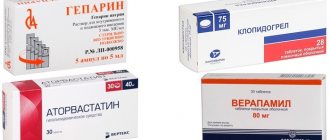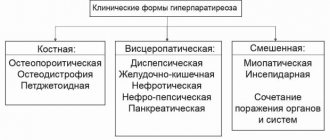What is a dissecting aortic aneurysm?
Dissecting aneurysms accompany intimal tearing. When a tear occurs, part of the blood passes into it and peels off the middle tunic of the aorta. An aneurysm can form along the entire course of the artery, block any of its branches, and affect the coronary arteries (in the case of retrograde dissections).
Retrograde dissection mostly affects the right artery and can lead to aortic valve insufficiency.
Photo of dissecting aortic aneurysm
Symptoms and signs of dissecting aortic aneurysm
Chest pain. In the classic case, it begins suddenly with very severe pain, predominantly in the anterior half of the chest, radiating to the interscapular region. Unlike AMI, the pain is very severe at the very beginning of its onset. Predominant localization of pain anterior to the chest accompanies upper aortic dissection, whereas pain in the interscapular region suggests lower aortic dissection. To describe pain, the patient usually uses such definitions as tearing, cutting, dagger pain.
Instant death or shock. Usually occurs due to aortic rupture or pericardial tamponade.
Congestive heart failure. Develops in acute aortic valve insufficiency and/or myocardial infarction.
- Stroke or acute ischemic heart disease of a limb due to compression or dissection.
- Paraplegia with sensory deficit as a result of occlusion of the spinal cord arteries.
- Myocardial infarction: usually in the territory of the right coronary artery.
Aortic dissection can occur without pain.
Assess the patient's history of hypertension, heart murmur, or aortic valve disease; previous chest X-ray findings may be useful for comparison with findings at the time of admission
Classification
There are two classifications of dissecting aortic aneurysms: Bakey and Stanford. The first implies the following types:
- I. Dissection occurs from the roots of the aorta and extends beyond the boundaries of the ascending aorta.
- II. The dissection is limited to the ascending aorta.
- III. The dissection occurs further from the center of the divergence of the left artery, located under the collarbone. Sometimes the dissection extends proximally to the direction of the aortic arch and its ascending region.
- IIIA. Dissection is limited to the thoracic aorta.
- IIIB. The delamination extends beyond the lower border of the diaphragm.
In modern practice, a more simplified Stanford classification is used, which implies 2 types of dissecting aneurysms:
- A. Affects the ascending aorta.
- B. Extending distally to the branching site of the left artery located under the clavicle.
How is a dissecting type aneurysm classified?
One of the indicators by which pathological formations on blood vessels differ is the form of the disease. She may be:
- chronic - the period of development is calculated in months;
- subacute - the pathological process reaches its peak within 4 weeks;
- acute - death can occur within 2 hours.
The clinical picture of an aortic aneurysm is closely related to the type of dissection. There are 3 of them in total.
- The process begins from the root of the aorta, gradually spreading beyond the ascending canal.
- Structural changes do not occur outside the ascending aorta.
- The initial section of the descending part of the thoracic aorta begins to be affected, namely the one located closer to the left subclavian.
Causes
Conditions affecting the muscular and elastic structures of the media lead to dissecting aneurysm. The main reason is, which is observed in 70-90% of patients. Hypertension is accompanied by overstrain and trauma to the aorta, which leads to the formation of aneurysms.
Also, the reason for the formation of a dissecting aortic aneurysm can be:
- Hereditary defects conn. tissues, for example, Marfan syndrome, Turner syndrome and others.
- Aortic defects or coarctation.
- Atherosclerosis.
- Systemic vasculitis.
- Polycystic kidney disease.
There are also factors that increase the risk of an aneurysm:
- age over 50 years;
- trauma to the thoracic region;
- pregnancy;
- rehabilitation after surgery on the heart and aorta.
The following video will tell you in more detail about the dangers of dissecting aortic aneurysm:
Examination for dissecting aortic aneurysm
Most patients are diagnosed with arterial hypertension at the time of admission. Hypotension is more common with upper aortic dissection (20-25%) and is due to blood loss, acute aortic incompetence (which may be accompanied by heart failure), or tamponade.
Check blood pressure in both arms and carefully evaluate the pulse in the peripheral vessels. The absence or change in the nature of the pulse indicates an expansion of the zone of dissection.
Auscultation may reveal regurgitation of the aortic valve and sometimes a pericardial friction rub. The consequence of rupture of the lower part of the aorta and the breakthrough of blood into the left pleural cavity may be dullness of sound in the left lower parts of the lungs, detected by percussion.
Neurologic deficits may result from carotid artery dissection, compression (hemiplegia), or occlusion of a spinal cord artery (paraplegia with sensory deficit).
- Congenital vascular diseases (bicuspid aortic valve)
- Inflammatory process in the wall of blood vessels (Coarctation of the aorta)
- Giant cell arteritis
- Takayasu arteritis
- Behçet's disease
- Syphilis
- Injury while braking (Road injury)
- Trauma (Fall from height)
- Pregnancy
- Iatrogenic disorders (Catheterization)
- Cardiac surgery
Marfan syndrome: the distance between the fingers of the hands apart is greater than the height, the distance from the pubic bone to the foot is greater than the distance from the pubic bone to the vertex, retraction of the sternum, scoliosis, gothic palate, anterior dislocation of the lens, dilatation of the thoracic aorta or aortic valve insufficiency, increased concentration in the urine hydroxyprolene (in some cases).
Symptoms
Most often, dissecting (dissecting) aortic aneurysm begins abruptly, with symptoms similar to urological and cardiovascular diseases:
- Pain in a large area, involving the sternum, shoulder blades and surrounding areas. The pain is acute, unbearable, and moves depending on the spread of the dissection.
- A persistent increase in blood pressure, which subsides after some time.
- General state of weakness.
- Pulse asymmetry.
- Increased sweating.
- Blueness of the skin.
- Impaired consciousness up to coma.
- Shortness of breath.
Aneurysm dissection may be accompanied by:
- Ischemia.
- Hemiparesis.
- Paraplegia.
- Peripheral neuropathy.
- Dysphagia.
- Cardiac tamponade.
- Hemopericardium.
If the descending aorta is affected, renovascular hypertension and acute renal failure develop.
Next we will talk about the diagnosis and treatment of dissecting aortic aneurysm.
Image of a dissecting aortic aneurysm
Flow. Causes[ | ]
Play media file
Video with subtitles
A dissecting aneurysm ends with complete rupture of the aorta within the next few hours or days. In rare cases, a dissecting aneurysm is opened into the vessel by rupturing the intima in another place (with self-healing). The initial part of the ascending limb is usually affected.[1] Etiopathogenetic factors include:
- atherosclerosis with significant changes in the vasa vasorum (vascular vessels) of the aorta, ischemia of the aortic wall;
- hypertension and sharp fluctuations in blood pressure;
- syphilis;
- focal necrosis of the vessel media of bacterial embolic origin in acute infectious diseases;
- congenital defects in the development of the aorta (coarctation, double arch, hypoplasia, patent ductus botallus, Marfan syndrome);
- physical and neuro-emotional stress;
- damage to the aorta by a related process (spondylitis, esophageal cancer, penetration of a peptic ulcer of the esophagus, duodenum) or a foreign body;
- closed injury to the chest or abdominal cavity.
Along the flow they distinguish:
- According to the course of aortic dissection (acute - up to 2 weeks, subacute - longer), which is important for assessing the prognosis, since 65-70% of untreated patients die within the first 14 days.
Diagnostics
As soon as a dissecting aneurysm is suspected, instrumental studies must be performed to prescribe appropriate treatment. To do this, the patient may be prescribed:
- X-ray. Shows the presence of an aneurysm, pleural effusion, pulsation of the dilating aorta.
- EchoCG. Determines the condition of the affected aorta, the exfoliated flap, true and false tubules, and the extent of the lesion.
- MRI and CT. These studies are only possible if the patient’s condition is stable, as they are time-consuming. Allows precise determination of the location and characteristics of the aneurysm.
- Ultrasound Doppler.
- Aortography.
The doctor also carries out differential diagnosis with acute infarction, occlusion and other diseases.
Diagnosis of dissecting aortic aneurysm
Echocardiography Transthoracic echocardiography can be used to diagnose aortic dilatation, aortic valve regurgitation, and pericardial effusion or tamponade. Transesophageal echocardiography is the preferred method because it allows better examination of the ascending and descending aorta, identification of the site of damage to the inner lining of the aorta, examination of the coronary artery ostia in relation to the site of aortic dissection, and also provides information about aortic valve insufficiency. However, transesophageal echocardiography does not allow examination of the distal part of the ascending aorta and the proximal part of the aortic arch.
MRI angiography is the “gold standard” of diagnosis. The method has all the advantages of transesophageal echocardiography, and also provides clear information about all parts of the upper aortic arch and lower aorta, as well as the vessels leaving the aorta. The image can be presented in the form of separate sections or a three-dimensional reconstruction can be performed. However, this method also has a number of disadvantages, such as:
- the need for the constant presence of qualified specialists on the hospital staff, the high cost of the study;
- the impossibility of conducting research in the presence of implanted metal structures (for example, an artificial pacemaker or heart valves);
- Monitoring an unstable patient in an MRI room is extremely difficult, which poses a threat to his life.
True and false lumens are identified by different directions of flow of the contrast agent, detection of the entry and exit points on the damaged vessel, and the location of the breakthrough into the pericardium or pleural cavity. However, this method does not show the damage to the aortic valve that accompanies upper aortic dissection.
Angiography. When contrast is administered through the femoral or axillary artery, one can observe the division of blood into two streams, insufficiency of the aortic valve, involvement of the branches of the aorta, and the site of rupture of the inner membrane itself. This is an invasive method that carries a huge risk of complications for the high-risk patient. Currently, the method is being replaced by CT, MRI and transesophageal echocardiography
Choosing a diagnostic method
Confirmation or refutation of the diagnosis of aortic dissection.
Is the dissection limited to the descending aorta or extends to the arch and upper aorta?
The extent of the defect, the location of entry and exit, and the presence or absence of blood clots are determined.
Detection of aortic valve insufficiency, involvement of coronary vessels and pericardial effusion.
Treatment
Treatment of dissecting aneurysm, unlike other forms of the disease, must be carried out urgently, since reverse effects can be fatal. Treatment can be medicinal and surgical.
Note! Do not try to cure a dissecting aneurysm with folk remedies! This is useless and may worsen the symptoms.
Surgery
Surgical treatment is carried out in parallel with medication and in the presence of certain indications:
- ascending aortic dissection;
- heart failure;
- external rupture;
- blood flow disorders;
- persistent sharp pain;
Often, operations on dissecting aneurysms are performed urgently, since there is a high probability of the patient dying even before they begin.
Operations can take place in two scenarios:
- Bentall's operation. Resection of the aortic valve is performed, followed by its replacement with a vascular implant.
- Suprocoronary aortic replacement. Possible only if there is slight aortic insufficiency. In this case, the valve can be preserved through plastic surgery.
The listed operations for dissecting aortic aneurysm take a lot of time and effort, are performed in the clinic with artificial circulation, and the patient loses a lot of blood.
A specialist will tell you more about the operation for dissecting aortic aneurysm in the following video:
Medication
Drug treatment is aimed at reducing blood pressure and myocardial contractility. For this purpose the following may be prescribed:
- nitroglycerin and sodium nitroprusside for rapid reduction;
- β-blockers to quickly reduce myocardial contractility;
- labetol according to the course: 10 mg IV over 2 minutes, 20-80 mg until reaching 300 mg every 10 minutes;
- verapamil or diltiazem if the patient is prohibited from taking β-blockers;
- angiotensin-converting enzymes, if you need to lower blood pressure during renal artery dissection;
If the patient has hypotension, he is advised to administer large amounts of fluid intravenously. The doctor may also prescribe other medications depending on the specific case.
Symptoms[ | ]
Symptoms depend on the stage and area of distribution of the dissecting aneurysm and can be very diverse. The sequence of appearance of clinical signs is determined:
- when the intima is torn - pain and collaptoid reactions;
- with dissection of the aortic wall - sharp migrating pain, anemia, organ symptoms and repeated collapsoid reactions;
- with complete rupture of the vessel wall - signs of internal bleeding and terminal hemorrhagic shock.
Organ symptoms are determined
- place of dissection and damage to outgoing vessels (coronary, subclavian, carotid, mesenteric, intercostal, renal, iliac, etc.);
- place of intimal tear (beginning of the aorta, supravalvular area, ascending section, aortic arch, descending thoracic aorta, abdominal section);
- site of hemorrhage (pericardium, mediastinum, pleural cavities, retroperitoneal tissue, abdominal cavity).
Depending on the factors listed above, pain can be localized or radiate to the chest, arms, neck, back, abdomen, lower back, legs. Characterized by severe pain (tearing, burning, tearing, pressing), leading to motor agitation. Fainting is possible when the vessels leading to the brain are damaged or due to anemia. Cyanosis of the upper half of the body is possible due to hemopericardium. In the initial period, bradycardia is possible as a result of irritation of the depressor nerves when the intima is torn; if internal bleeding occurs, it is replaced by tachycardia.
The electrocardiographic picture is variable. The ECG in infarction-like form remains normal in approximately 1/3 of cases. In other cases, the ECG shows signs of coronary insufficiency or focal changes in the myocardium. Dissecting aortic aneurysm is characterized by persistent persistence of these signs on repeated ECGs. Dynamic ECG changes characteristic of myocardial infarction are not detected. Increasing anemia constantly occurs with dissecting aortic aneurysm and is not typical for myocardial infarction. Summarizing the above, we can say that pain dominates the clinical picture of a dissecting aneurysm, and that, as with myocardial infarction, it occurs with leukocytosis. The main differences from MI are that pain and leukocytosis with RAA, both at the time of its occurrence and at a later date, are not combined with ECG changes characteristic of MI. There may be signs of angina pectoris and even myocardial infarction, which is associated with irritation of the vascular adventitia and compression of the coronary arteries. Possible aortic dissection in the area of the mouths of the coronary vessels. Neurological symptoms (hemiplegia, loss of consciousness, convulsions, paraplegia, pelvic organ dysfunction) are associated with compression of the vessels of the brain or spinal cord. Renal symptoms such as renal colic, paranephritis, reflex anuria are caused by compression of the renal vessels. Disorder of the blood supply to the lower extremities occurs due to compression or damage to the iliac and femoral arteries.
An enlarging, pulsatile abdominal swelling is characteristic of a dissecting abdominal aortic aneurysm. With hemorrhage in the mediastinum, pleural cavity, or pericardium, corresponding physical signs may be observed - displacement of the boundaries of the organs of the chest cavity, expansion of the boundaries of absolute cardiac dullness. When recording an ECG at the moment of cessation of the mechanical activity of the heart (that is, when the blood circulation stops) from cardiac tamponade when the initial part of the aorta ruptures into the pericardial cavity, electrical activity with gradual extinction may be observed (sinus rhythm, bradycardia, atrioventricular block, low pacemaker, asystole).
In the initial period of the disease, regardless of signs of peripheral circulatory failure (pallor, cold sweat), an increase in A/D may be observed.
Urgent Care
Emergency care for dissecting aortic aneurysm can only be provided by an ambulance team. Measures consist of relieving symptoms and stabilizing the patient; for this, the following can be used:
- morphine in solution at a dose of 0.5 intravenously;
- dopamine, if there are collaptoid reactions, at a dosage of 400 mg of the drug per 400 ml of saline solution.
- metazone;
If a patient experiences an increase in blood pressure, he is prescribed antihypertensive drugs, for example, sodium nitroprusside.
Scheme of stages of dissecting aortic aneurysm
Surgical and drug treatment
Vessel endoprosthetics
A patient diagnosed with a dissecting aortic aneurysm is first hospitalized, after which the doctor decides on intensive care. Conservative action consists of taking medications such as:
- beta blockers;
- calcium antagonists;
- ACE inhibitors;
- nitroglycerine.
It is especially important during this period to control blood pressure levels, which can drop sharply and provoke collapse. In view of this, a patient who is undergoing hospital treatment is given an x-ray every 12 hours.
As for surgical intervention, it is carried out only under direct indications, the most important of which is the threat of rupture of the aortic wall. Also, indications for surgery include a persistent increase in blood pressure and the acquisition of a saccular shape by the aneurysm. Surgical treatment consists of replacing the damaged segment of the main blood vessel.
Disease prevention
Prevention of dissecting aneurysm is aimed at controlling and preventing cardiovascular diseases. To do this you need:
- See a cardiologist once every six months.
- Monitor and regulate blood pressure.
- Check and reduce cholesterol levels if necessary.
- Stop smoking and drinking alcohol in large quantities.
It is useful to train the heart muscle. Cardio exercises and a healthy lifestyle are suitable for this.











